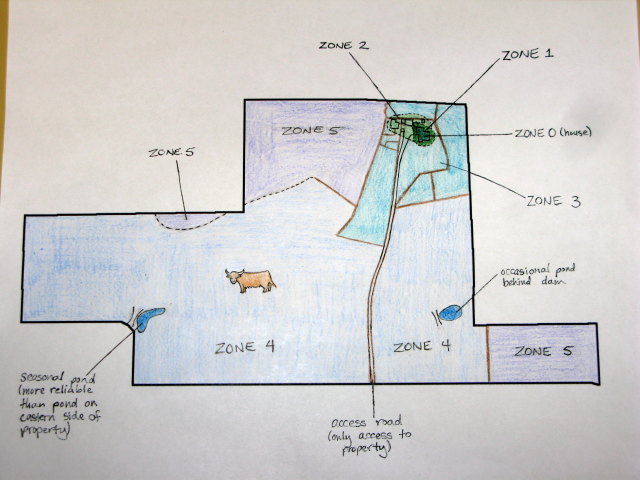Permaculture Design Certificate Final Presentation – Table Rock Ranch
- Sarah Spotten

My mother and father-in-laws, Win and Mike, live on a beautiful and rugged piece of land on Colorado’s Front Range known as Table Rock Ranch. For over 25 years, Win and Mike have raised a small herd of Scottish Highland beef cattle on the 85-acre property using a largely pastured, grass-fed approach. The ranch lies on the high plains about 15 miles as the crow flies from the eastern slope of the Rocky Mountains and at about 7,300 feet elevation. The ranch is named for a mesa on part of the property called Table Rock, which is an easily-recognizable landmark in the area and which is an important Native American site. There is an authentic Native American medicine wheel on top of the mesa, which is still visited occasionally by members of the Ute nation. Table Rock was previously the resting place of a Native American holy man (who was exhumed in the 20th century), and may still be home to some as-yet unconfirmed Native American grave sites.
In choosing to do my final design for my Permaculture Design Certificate with Table Rock Ranch, my overall goal was to help my in-laws live more sustainably on their land and more abundantly on their small budget. Some challenges to design for are:
- elevation (7,300’ above sea level)
- semi-arid climate (16” of rain per year on average)
- continuing drought (estimated to continue into 2013 and possibly beyond)
- short growing season (last frost usually in May, first frost usually in September)
- low percentage of organic matter in the soil
The aim of this particular permaculture design for was to present practical, attainable, real-world goals and use techniques that could easily be implemented by Mike and Win right now. For this reason, I did not delve into large, whole-property designs that might have seemed overwhelming and insurmountable, but focused on making smaller changes to the current system that would bring the greatest immediate benefits, or on goals that have already been voiced by Mike and Win.
Working through this design for my PDC really helped cement two ideas that are oft-repeated by permaculturists in my mind:
- The problem is the solution:
- Example one: kitchen scraps at Table Rock Ranch that otherwise go to waste can, though several biological processes, become food again
- Example two: the ranch’s pastures are already trying to rebuild themselves, as evidenced by the weeds, we just need to help them along in their process of succession
- The importance of observation cannot be overstated – at first a problem and its solution may look simple, but we must look at the situation from a holistic perspective to really understand the appropriate action to take. It would have been easy to “go crazy” with the design for this 85-acre parcel and turn it into the ultimate permaculture Eden, but observing the landscape also means observing the people who already live there, and their willingness and able-ness (physical and/or financial) to turn the design into reality.
For more information on this project and to take a look at the presentation I gave to complete my Permaculture Design Certificate, please follow one of the two links below:
Table Rock Ranch Permaculture Design Presentation by Sarah Spotten – Google Documents/Drive version
Table Rock Ranch Permaculture Design Presentation by Sarah Spotten – Microsoft PowerPoint version
![photo[1]](https://b2792463.smushcdn.com/2792463/wp-content/uploads/2012/06/photo1.jpg?lossy=0&strip=1&webp=1) Sarah Spotten currently lives in Colorado, and with this design has completed one of our PDC Completion Home Correspondence Courses. As part of her course requirements she posted occasionally on topics related to her curriculum A big congratulations to her from Midwest Permaculture! Sarah Spotten currently lives in Colorado, and with this design has completed one of our PDC Completion Home Correspondence Courses. As part of her course requirements she posted occasionally on topics related to her curriculum A big congratulations to her from Midwest Permaculture!
You can see other posts by Sarah here. Her current projects can be found at http://sarahspotten.com. |
